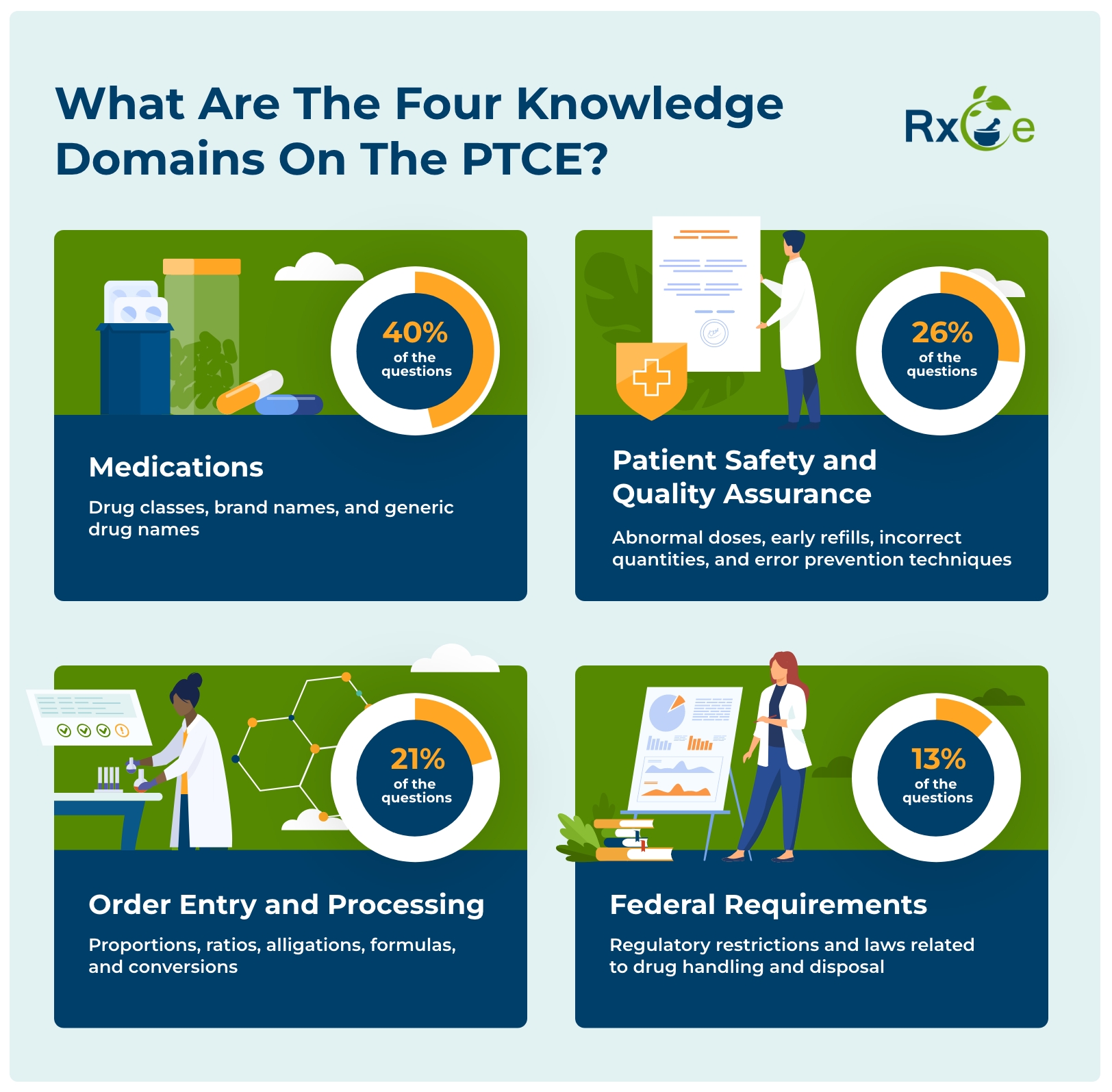As a pharmacy technician, pursuing certification is a critical step in your career. If you plan to take the Pharmacy Technician Certification Board exam to obtain your certification, preparing for the test with a robust PTCB exam study guide can play a key role in your success.
Fortunately, RxCe’s study guide is here to help you ensure you understand the material covered as well as the exam format so you can develop a viable test-taking strategy. With the right guidance and a commitment to studying, you can get on the path to enhancing your professional knowledge and building a robust career.
2025 PTCB Exam Syllabus
Understanding what is covered on the PTCB exam will ensure that you focus your study time on the most relevant material. Here is what you will need to know to give yourself the best chance of passing your exam on the first attempt.
The Four Knowledge Domains
Medications (40% of the Questions)
As a pharmacy technician, dispensing medications is one of the most essential parts of your role. Thus, it makes sense that knowledge of this domain accounts for most of your certification exam.
Your test preparation should include a significant amount of pharmacology knowledge, including drug classes (such as antihistamines, statins, and antifungal drugs), brand names, and generic drug names. You’ll also need to understand the concept of therapeutic equivalence, including pharmaceutical equivalence and bioequivalence.
To ensure patient safety, you should also understand how drugs interact with each other and be able to spot common contraindications between drugs, diseases, dietary supplements, laboratory tests, and nutrients, as knowing when not to dispense a drug can be life-saving for a patient.
You’ll need to know about narrow therapeutic index (NTI) medications, which only provide a small margin between a safe dose and a potentially toxic or ineffective one. Understanding common and severe side effects, allergic reactions, and adverse effects is also integral to patient safety and can help you properly educate patients about their health.
Finally, the PTCB exam will require some in-depth knowledge of medication composition and administration, including strengths/dose, dosage forms, routes and instructions for administration, drug therapy duration, and special handling.
You should also understand drug stability in different forms (such as reconstitutables, oral suspensions, injectables, insulin, and vaccinations), chemical and physical incompatibilities related to non-sterile compounding and reconstitution, and proper medication storage to ensure the right temperature, lighting, and access restrictions.
Patient Safety & Quality Assurance (26% of Questions)
Just over one quarter of the PTCB exam is dedicated to the knowledge you will need to deliver quality service, advice, and prescription drugs that keep patients out of harm’s way.
For this portion of the test, you’ll need to understand different types of prescription errors, such as abnormal doses, early refills, and incorrect quantities, as well as error prevention techniques. These may include:
- Using Tall Man lettering to highlight differences between look-alike/sound-alike (LASA) drugs
- Separating inventory
- Using and omitting leading and trailing zeros
- Using barcodes
- Limiting the use of error-prone abbreviations
In your PTCB exam prep, you’ll want to focus on identifying high-alert/risk drugs and understanding which issues require intervention from a pharmacist, including:
- Drug utilization reviews (DURs)
- Adverse drug events (ADEs)
- Over-the-counter drug recommendations
- Therapeutic substitutions
- Post-immunization follow-up
- Drug allergies and interactions
- Issues of misuse and adherence
The exam will require knowledge of proper hygiene and cleaning standards, including handwashing, personal protective equipment, and cleaning surfaces.
You will also need to know event reporting procedures for medication errors, adverse effects, near misses, and product integrity issues. This includes reporting through MedWatch, the FDA’s official program for reporting adverse reactions and quality problems.
Order Entry and Processing (21% of Questions)
Order entry and processing-related questions account for about one-fifth of the PTCB exam study guide. To do well, you’ll need to know compounding procedures for non-sterile products like ointments, liquids, and emulsions as well as medical terminology, abbreviations, symbols, and sig codes.
You’ll also be required to understand mathematical calculations, proportions, ratios, alligations, formulas, and conversions to ensure correct quantities, concentrations, and dosing.
Additionally, you should be able to identify and know how to use drug administration equipment, including oral and injectable syringes, spacers, diabetic supplies, and unit dose packaging and know how National Drug Code (NDC) numbers, expiration dates, and lot numbers are used for differentiating, tracking, and maintaining quality control.
Finally, familiarize yourself with best practices for returning dispensable, non-dispensable, and expired medications and supplies, including credit return, return to stock, and reverse distribution.
Federal Requirements (13% of the Questions)
The federal requirements section of the PTCB exam covers crucial topics related to regulatory restrictions and laws related to drug handling and disposal. For this portion, you should know what to do with medications, devices, supplies, and supplements in the event of an FDA recall.
You should also have knowledge of DEA-controlled drugs and procedures for receiving, storing, ordering, labeling, and dispensing new, refill, and transfer controlled substance prescriptions.
Understanding reverse distribution, take-back and restricted drug programs, and how to report loss or theft is also crucial for answering questions about controlled substances.
PTCB Pharmacy Math
Mathematical skills are essential for pharmacy technicians to accurately calculate drug dosages, conversions, and supplies. To pass the exam and excel in the field, your PTCB exam study guide should include skills in basic arithmetic, fractions, decimals, percentages, metric conversions, and Roman numerals. In addition, there are sample PTCB quizzes available on the internet.
How Many PTCB Pharmacy Math & Calculation Questions Are on the Test?
Not all candidates will receive the same number of math questions, so there is no standard answer to this question. You may receive ten or more, while others get fewer. Consequently, it’s important to have a well-rounded set of math skills so that you can do well with calculations across exam domains.
What Types of Pharmacy Math Should You Know?
You will encounter many math calculations both on your PTCB exam study guide and in your profession, and knowing basic arithmetic, decimals, and metric conversions will get you far. However, obtaining the highest possible score will require an in-depth understanding of pharmacy math in these essential domains:
- Dosing / Quantity
- Formulas
- Alligations
- Concentrations
- Dilutions
- Conversions
- Roman Numerals
- Prescription Interpretation
- Compounding Non-Sterile Medicines
- Parenteral Solutions IV Flow Rates/Infusions
- Body Mass Index
- Body Surface Area
- Pediatric Dose Calculations
- Retail Pharmacy
The Top 200 Drugs & Medicines
Knowing the most common and critical drugs is essential for passing the PTCB. The exam heavily emphasizes medication knowledge, including brand and generic names, indications and contraindications, and side effects.
Tips for Memorizing 200 Drugs
Keep in mind that many medications are named after — and therefore sound just like — the active ingredient in the drug. For example, the antipsychotic drug Risperdal sounds like it's active ingredient risperidone. Other drug names relate more to how the drug works or the disease they are designed to treat. Tamiflu is an antiviral used to treat influenza, which explains why the brand name ends in “-flu.” Try incorporating these strategies in your PTCB exam study guide to help you eliminate incorrect answers on multiple-choice questions.
Many forums have suggested memorizing the most common drugs first, including their generic and brand names, and then moving on to memorizing 10 medications at a time. While 200 medications might seem like a lot to memorize, it's important to remember that no test is the same. The questions are randomized each time you take the test. One person might get more medication-related questions than another. You might have one question around medications or 15 questions; it’s better to be prepared.
Passing the PTCE
The PTCB exam includes 80 scored questions. With a score range of 1000 to 1,600, you must achieve a scaled score of at least 1,400 to pass the exam. A panel of experts used a modified Angoff method to estimate the percentage of qualified pharmacy technicians who would be able to answer each question correctly and used this data to determine a passing scaled score.
What Happens if You Fail?
PTCB guidelines indicate that you do not have to wait to take the exam a second or third time. However, a fourth attempt will require a six-month waiting period as well as proof of the completion of acceptable preparation activities. This proof can come in the form of receipts or an agreement for tutoring services, or participation in an academic program.
It’s important to note that the PTCB says, “PTCB exams are highly reliable, which means that candidates who fail the exam should expect to fail again unless they increase their knowledge of the exam content through additional preparation.” So, if you do fail, it’s ok, but you must better prepare for the next time.
When Should You Take the Exam?
There are some logistical things you will need to take care of before you take the PTCB exam. For example, you’ll need to complete a PTCB-recognized education or training program or obtain a minimum of 500 hours of work experience as a pharmacy technician.
Still, even after your logistical to-dos are taken care of, you should ensure that you are confident in your knowledge of the exam material before you sit for the test. You should be able to explain concepts clearly and understand how to apply your knowledge to real-world scenarios.
You can prove your comfort level with the material and with the exam format and pacing by trying your hand at a few timed practice tests. If you can manage your time well to easily finish within the two-hour time limit and achieve consistently high scores, you will know that you’re ready for the real thing.
While it’s important to give yourself ample time to study for the test after completing an education program, don’t let too much time pass before you attempt the exam. It is often a good idea to sit for the test when the material is still fresh in your mind.
PTCB Exam Format & Structure
Knowing the format and structure of the test can help reduce test anxiety and allow you to develop a proper time management strategy to maximize success. The PTCB exam consists of 90 questions, only 80 of which will be scored.
You won’t know which questions are not scored, so your PTCB exam study guide must prepare you to answer all of them accurately. Each candidate will have two hours to finish all 90 questions, in addition to a short five-minute tutorial at the beginning and a five-minute survey at the end of the test.
All questions on the exam are multiple choice and have four possible answers. However, only one out of those four choices will be the correct answer. Proper PTCB exam preparation can help you learn to eliminate incorrect answers to discover the right choice. The test is computerized and administered online, but you must take it at an approved Pearson VUE testing center.
How RxCe Supports Your Professional Growth After Certification
Becoming a certified pharmacy technician can be an exciting prospect. It takes a lot of work with a good PTCB exam study guide to pass the exam, and it’s an accomplishment you should certainly be proud of. However, it’s also important to remember that the work doesn’t stop at certification.
Many states require pharmacy technicians to engage in continuing education courses to maintain their certifications. Even if your state does not, the Pharmacy Technician Certification Board does require it with your renewal application. Continuing education courses help you maintain your professional competency and stay up to date with current regulations and best practices in the field.
If you’re looking for a convenient option for your CE courses, RxCe is here to help. We offer a wide range of CE courses tailored to PTCB and state requirements, as well as a variety of career interests. We provide affordable options bundled in an unlimited membership that gives you access to all courses and live webinars.
All of RxCe’s courses and programs are ACPE-approved and accredited and report to CPE Monitor and CeBroker for your convenience.
The RxCe team has over two decades of experience providing continuing education for pharmacy technicians looking to further their careers. Enroll in a course or membership today to see how we can help you achieve and maintain your professional goals.








